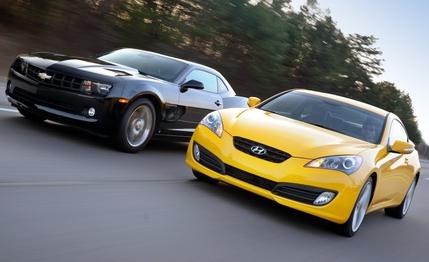 Comparison Tests
Comparison Tests
We expect your palms are all clammy in anticipation of the predictable Detroit Three muscle-car comparo, in which belching V-8s reduce tires to a gray haze that hangs on the horizon like a thousand dirty sweat pants. We’ll produce the gray haze in due course.
But first, let’s be responsible by looking at where most pony-car transactions transpire—that is, in the V-6 trenches, accounting for 65 percent of sales—and then let’s be irresponsible by celebrating this: The 2010 Camaro V-6 is 0.7 second quicker to 60 mph than, say, a Camaro SS 396 we tested in 1968. Heck, it’s quicker and faster through the quarter-mile than a BMW 328i. No chicken coupe, this.
So we sent out invitations, but Ford and Dodge didn’t RSVP, choosing silence instead. Here’s why: The Camaro LT and the Hyundai Genesis Coupe 3.8 are both spanking-new four-valve twin-cammers with independent multilink rear suspensions, and their outputs are on top of each other: 306 horsepower for the Genesis, 304 for the Camaro. Neither Ford nor Dodge can make like claims. It’s more than a little frustrating that the V-6 in Ford’s latest Mustang produces a pitiful 210 horses from greater displacement than either Chevrolet or Hyundai requires. Unless Ford equips the Mustang with, say, an EcoBoost V-6, Dearborn simply won’t have a horse in this race. Dodge’s V-6 Challenger—automatic only—isn’t much better off, producing 250 horsepower from 3.5 liters. A V-6 Challenger we tested achieved 60 mph in 7.5 seconds, leaving it embarrassingly in the wake of the two cars gathered here, in part because the Dodge is one big lunker—more than 15 inches longer than a Genesis coupe. Which left us with this unlikely but toothsome twosome: a 3.6-liter V-6 Camaro versus a 3.8-liter Genesis coupe. America versus Korea. Except the Camaro is built in Oshawa, Ontario. So let’s call it Oshawa versus Ulsan.